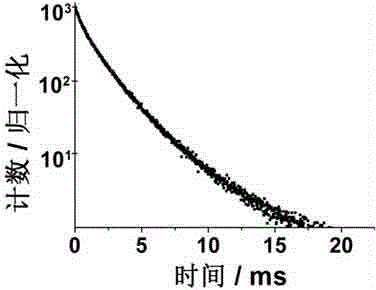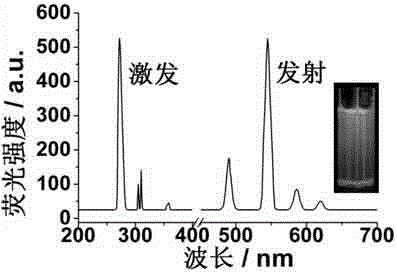Preparation method and application of fluorescent sensor for detecting microRNA
A fluorescent sensor and microRNA technology, which is applied in fluorescence/phosphorescence, material excitation analysis, etc., can solve the problems of autofluorescence interference, bleaching, etc., and achieve the effect of simple preparation method, low cost and safe operation
- Summary
- Abstract
- Description
- Claims
- Application Information
AI Technical Summary
Problems solved by technology
Method used
Image
Examples
Embodiment 1
[0034] A method for preparing a fluorescent sensor for detecting microRNA, comprising the following steps:
[0035] 1) Preparation of polyacrylic acid (PAA)-modified GdF by solvothermal method 3 :Tb 3+ Nanoparticles
[0036] In a 50 mL round bottom flask, add 0.1 mmol GdCl to 12 mL, 17-18.2 MΩcm ultrapure water and 4.0 mL ethylene glycol mixed solvent 3 ·6H 2 O, 80 mg polyacrylic acid and 2.0 μmol TbCl 3 ·6H 2 O, stir until uniform and transparent, then heat to 50°C to obtain solution a; add 0.3mmol NH to 5.0mL ultrapure water and 2.0mL ethylene glycol mixed solvent in a 15mL test tube 4 F, stir at room temperature until uniform and transparent, then heat to 50°C to obtain solution b, while hot, add solution b dropwise to solution a at a rate of 1 drop per second, react for 30 minutes, centrifuge at 2000rpm for 5 minutes to collect solid products, and use Wash twice with ultrapure water and ethanol, and dry in vacuum for 10 hours to obtain polyacrylic acid-modified GdF ...
Embodiment 2
[0053] A method for preparing a fluorescent sensor for detecting microRNA, comprising the following steps:
[0054] 1) In a 100mL round bottom flask, add 0.2mmolGdCl to 17-18.2MΩcm, 24mL ultrapure water and 8.0mL ethylene glycol mixed solvent 3 ·6H 2 O, 160 mg polyacrylic acid and 4.0 μmol TbCl 3 ·6H 2 O, stir until uniform and transparent, then heat to 50°C to obtain solution a; add 0.6mmol NH to 10mL ultrapure water and 4.0mL ethylene glycol mixed solvent in a 50mL test tube 4 F, stir at room temperature until uniform and transparent, then heat to 50°C to obtain solution b, while hot, add solution b dropwise to solution a at a rate of 1 drop per second, react for 30 minutes, centrifuge at 2000rpm for 5 minutes to collect solid products, and use Wash twice with ultrapure water and ethanol, and dry in vacuum for 10 hours to obtain polyacrylic acid-modified GdF 3 :Tb 3+ Nanoparticle white powder product;
[0055] 2) Using 1-ethyl-(3-dimethylaminopropyl) carbodiimide (EDC)...
Embodiment 3
[0066] A method for preparing a fluorescent sensor for detecting microRNA, comprising the following steps:
[0067] 1) In a 100mL round bottom flask, add 0.15mmolGdCl to 17-18.2MΩcm, 18mL ultrapure water and 6.0mL ethylene glycol mixed solvent 3 ·6H 2 O, 120 mg polyacrylic acid and 3.0 μmol TbCl 3 ·6H 2 O, stir until uniform and transparent, then heat to 50°C to obtain solution a; add 0.45mmol NH to 7.5mL ultrapure water and 3.0mL ethylene glycol mixed solvent in a 15mL test tube 4 F, stir at room temperature until uniform and transparent, then heat to 50°C to obtain solution b, while hot, add solution b dropwise to solution a at a rate of 1 drop per second, react for 30 minutes, centrifuge at 2000rpm for 5 minutes to collect solid products, and use Wash twice with ultrapure water and ethanol, and dry in vacuum for 10 hours to obtain polyacrylic acid-modified GdF 3 :Tb 3+ Nanoparticle white powder product;
[0068] 2) Using 1-ethyl-(3-dimethylaminopropyl) carbodiimide (E...
PUM
 Login to View More
Login to View More Abstract
Description
Claims
Application Information
 Login to View More
Login to View More - R&D
- Intellectual Property
- Life Sciences
- Materials
- Tech Scout
- Unparalleled Data Quality
- Higher Quality Content
- 60% Fewer Hallucinations
Browse by: Latest US Patents, China's latest patents, Technical Efficacy Thesaurus, Application Domain, Technology Topic, Popular Technical Reports.
© 2025 PatSnap. All rights reserved.Legal|Privacy policy|Modern Slavery Act Transparency Statement|Sitemap|About US| Contact US: help@patsnap.com



